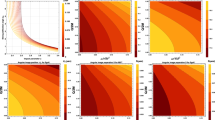Abstract
The Hubble constant, H 0, sets the scale of the size and age of the Universe and its determination from independent methods is still worthwhile to be investigated. In this article, by using the Sunyaev–Zeldovich effect and X-ray surface brightness data from 38 galaxy clusters observed by Bonamente et al. (Astrophys J 647:25, 2006), we obtain a new estimate of H 0 in the context of a flat Λ CDM model. There is a degeneracy on the mass density parameter (Ω m ) which is broken by applying a joint analysis involving the baryon acoustic oscillations (BAO) as given by Sloan Digital Sky Survey. This happens because the BAO signature does not depend on H 0. Our basic finding is that a joint analysis involving these tests yield \({H_0 = 76.5^{+3.35}_{-3.33}}\) km/s/mpc and \({\Omega_{m} = 0.27^{+0.03}_{-0.02}}\). Since the hypothesis of spherical geometry assumed by Bonamente et al. is questionable, we have also compared the above results to a recent work where a sample of galaxy clusters described by an elliptical profile was used in analysis.
Similar content being viewed by others
References
Sunyaev R.A., Zeldovich Ya.B.: The observations of relic radiation as a test of the nature of X-ray radiation from the clusters of galaxies. Comments Astrophys. Space Phys. 4, 173 (1972)
Itoh N., Kohyama Y., Nozawa S.: Relativistic corrections to the Sunyaev-Zeldovich effect for clusters of galaxies. Astrophys. J. 502, 7 (1998)
Bartlett J.G.: The Sunyaev-Zeldovich effect and its uses. Astrophys. Space Sci. 290, 105 (2004)
Silk J., White S.D.M.: The determination of Q0 using X-ray and microwave observations of galaxy clusters. Astrophys. J. 226, L103 (1978)
Cavaliere A., Danese L., De Zotti G.: Cosmic distances from X-ray and microwave observations of clusters of galaxies. Astron. Astrophys. 75, 322 (1979)
Birkinshaw M.: The Sunyaev-Zeldovich effect. Phys. Rep. 310, 97 (1999)
Carlstrom J.E., Holder G.P., Reese E.D.: Cosmology with the Sunyaev-Zeldovich effect. ARA&A 40, 643 (2002)
Reese E.D. et al.: Determining the cosmic distance scale from interferometric measurements of the Sunyaev-Zeldovich effect. Astrophys. J. 581, 53 (2002)
Jones M.E. et al.: H0 from an orientation-unbiased sample of Sunyaev-Zeldovich and X-ray clusters. MNRAS 357, 518 (2002)
De Filippis E., Sereno M., Bautz M.W., Longo G.: Measuring the three-dimensional structure of galaxy clusters. I. Application to a sample of 25 clusters. Astrophys. J. 625, 108 (2005)
Bonamente M. et al.: Determination of the cosmic distance scale from Sunyaev-Zeldovich effect and Chandra X-ray measurements of high-redshift galaxy clusters. Astrophys. J. 647, 25 (2006)
LaRoque S. et al.: X-ray and Sunyaev-Zeldovich effect measurements of the gas mass fraction in galaxy clusters. Astrophys. J. 652, 917 (2006)
Reiprich T.H., Bohringer H.: The mass function of an X-ray flux-limited sample of galaxy clusters. Astrophys. J. Lett. 567, 716 (2002)
Shang C., Haiman Z., Verde L.: Probing cosmology and galaxy cluster structure with the Sunyaev-Zeldovich decrement versus X-ray temperature scaling relation. MNRAS 400, 1085 (2009)
Fox D.C., Pen U.-L.: The distance to clusters: correcting for asphericity. Astrophys. J. 574, 38 (2002)
Jing Y.P., Suto Y.: Triaxial modeling of halo density profiles with high-resolution N-body simulations. Astrophys. J. 574, 538 (2002)
Plionis M., Basilakos S., Ragone-Figueroa C.: Morphological and dynamical properties of low-redshift two degree field galaxy redshift survey groups. Astrophys. J. 650, 770 (2006)
Sereno M., De Filippis E., Longo G., Bautz M.W.: Measuring the three-dimensional structure of galaxy clusters. II. Are clusters of galaxies oblate or prolate?. Astrophys. J. 645, 170 (2006)
Morandi A., Pedersen K., Limousin M.: Unveiling the three-dimensional structure of galaxy clusters: resolving the discrepancy between X-ray and lensing masses. Astrophys. J. 713, 491 (2010)
Etherington, I.M.H.: On the definition of distance in general relativity. Philos. Mag. 15, 761 (1933); Reprinted in Gen. Relativ. Gravit. 39, 1055, 2007
Holanda R.F.L., Lima J.A.S., Ribeiro M.B.: Testing the distance-duality relation with galaxy clusters and type Ia supernovae. Astrophys. J. Lett. 722, L233 (2010)
Holanda R.F.L., Lima J.A.S., Ribeiro M.B.: Cosmic distance duality relation and the shape of galaxy clusters. Astron. Astrophys. Lett. 528, L14 (2011)
Li Z., Wu P., Yu H.: Cosmological-model-independent tests for the distance-duality relation from galaxy clusters and type Ia supernova. Astrophys. J. Lett. 729, L14 (2011)
Eisenstein D.J.: Detection of the baryon acoustic peak in the large-scale correlation function of SDSS luminous red galaxies. Astrophys. J. 633, 560 (2005)
Komatsu E et al.: Seven-year Wilkinson Microwave Anisotropy Probe (WMAP) observations: cosmological interpretation. Astrophys. J. Ser. 192, 18 (2011)
Cunha J.V., Marassi L., Lima J.A.S.: Constraining H0 from the Sunyaev-Zeldovich effect, galaxy cluster X-ray data and baryon oscillations. MNRAS 379, L1 (2007)
Cavaliere A., Fusco-Fermiano R.: The distribution of hot gas in clusters of galaxies. Astron. Astrophys. 667, 70 (1978)
Lima J.A.S., Alcaniz J.S.: Constraining the cosmic equation of state from old galaxies at high redshift. Astron. Astrophys. 357, 393 (2000) [astro-ph/0003189]
Riess A. et al.: A 3% solution: determination of the hubble constant with the hubble space telescope and wide field camera 3. Astrophys. J. 730, 119 (2011)
Freedman W.L. et al.: Final results from the hubble space telescope key project to measure the hubble constant. Astrophys. J. 553, 47 (2001)
Mason B.S. et al.: A measurement of H0 from the Sunyaev-Zeldovich effect. Astrophys. J. 555, L11 (2001)
Reese, E.D.: Measuring and modeling the universe. In: Freedman, W.L. (ed.), p. 138. Cambridge University Press, Cambridge (2004)
Author information
Authors and Affiliations
Corresponding author
Rights and permissions
About this article
Cite this article
Holanda, R.F.L., Cunha, J.V. & Lima, J.A.S. New constraints on H 0 and Ω m from SZE/X-ray data and baryon acoustic oscillations. Gen Relativ Gravit 44, 501–508 (2012). https://doi.org/10.1007/s10714-011-1292-5
Received:
Accepted:
Published:
Issue Date:
DOI: https://doi.org/10.1007/s10714-011-1292-5




